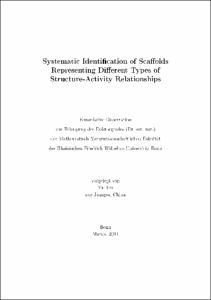Systematic Identification of Scaffolds Representing Different Types of Structure-Activity Relationships

Systematic Identification of Scaffolds Representing Different Types of Structure-Activity Relationships

| dc.contributor.advisor | Bajorath, Jürgen | |
| dc.contributor.author | Hu, Ye | |
| dc.date.accessioned | 2020-04-16T22:29:15Z | |
| dc.date.available | 2020-04-16T22:29:15Z | |
| dc.date.issued | 22.07.2011 | |
| dc.identifier.uri | https://hdl.handle.net/20.500.11811/4993 | |
| dc.description.abstract | In medicinal chemistry, it is of central importance to understand structure-activity relationships (SARs) of small bioactive compounds. Typically, SARs are analyzed on a case-by-case basis for sets of compounds active against a given target. However, the increasing amount of compound activity data that is becoming available allows SARs to be explored on a large-scale. Moreover, molecular scaffolds derived from bioactive compounds are also of high interest for SAR analysis. In general, scaffolds are obtained by removing all substituents from rings and from linkers between rings. This thesis aims at systematically mining compounds for which activity annotations are available and investigating relationships between chemical structure and biological activities at the level of active compounds, in particular, molecular scaffolds. Therefore, data mining approaches are designed to identify scaffolds with different structural and/or activity characteristics. Initially, scaffold distributions in compounds at different stages of pharmaceutical development are analyzed. Sets of scaffolds that overlap between different stages or preferentially occur at certain stages are identified. Furthermore, a systematic selectivity profile analysis of public domain active compounds is carried out. Scaffolds that yield compounds selective for communities of closely related targets and represent compounds selective only for one particular target over others are identified. In addition, the degree of promiscuity of scaffolds is thoroughly examined. Eighty-three scaffolds covering 33 chemotypes correspond to compounds active against at least three different target families and thus are considered to be promiscuous. Moreover, by integrating pairwise scaffold similarity and compound potency differences, the propensity of scaffolds to form multi-target activity or selectivity cliffs and, in addition, the global scaffold potential of individual targets are quantitatively assessed, respectively. Finally, structural relationships between scaffolds are systematically explored. Most scaffolds extracted from active compounds are found to be involved in substructure relationships and/or share topological features with others. These substructure relationships are also compared to, and combined with, hierarchical substructure relationships to facilitate activity prediction. | en |
| dc.language.iso | eng | |
| dc.rights | In Copyright | |
| dc.rights.uri | http://rightsstatements.org/vocab/InC/1.0/ | |
| dc.subject | Pharmazeutische Chemie | |
| dc.subject.ddc | 540 Chemie | |
| dc.subject.ddc | 610 Medizin, Gesundheit | |
| dc.title | Systematic Identification of Scaffolds Representing Different Types of Structure-Activity Relationships | |
| dc.type | Dissertation oder Habilitation | |
| dc.publisher.name | Universitäts- und Landesbibliothek Bonn | |
| dc.publisher.location | Bonn | |
| dc.rights.accessRights | openAccess | |
| dc.identifier.urn | https://nbn-resolving.org/urn:nbn:de:hbz:5N-25643 | |
| ulbbn.pubtype | Erstveröffentlichung | |
| ulbbnediss.affiliation.name | Rheinische Friedrich-Wilhelms-Universität Bonn | |
| ulbbnediss.affiliation.location | Bonn | |
| ulbbnediss.thesis.level | Dissertation | |
| ulbbnediss.dissID | 2564 | |
| ulbbnediss.date.accepted | 09.06.2011 | |
| ulbbnediss.fakultaet | Mathematisch-Naturwissenschaftliche Fakultät | |
| dc.contributor.coReferee | Gütschow, Michael |
Dateien zu dieser Ressource
Das Dokument erscheint in:
-
E-Dissertationen (4442)




